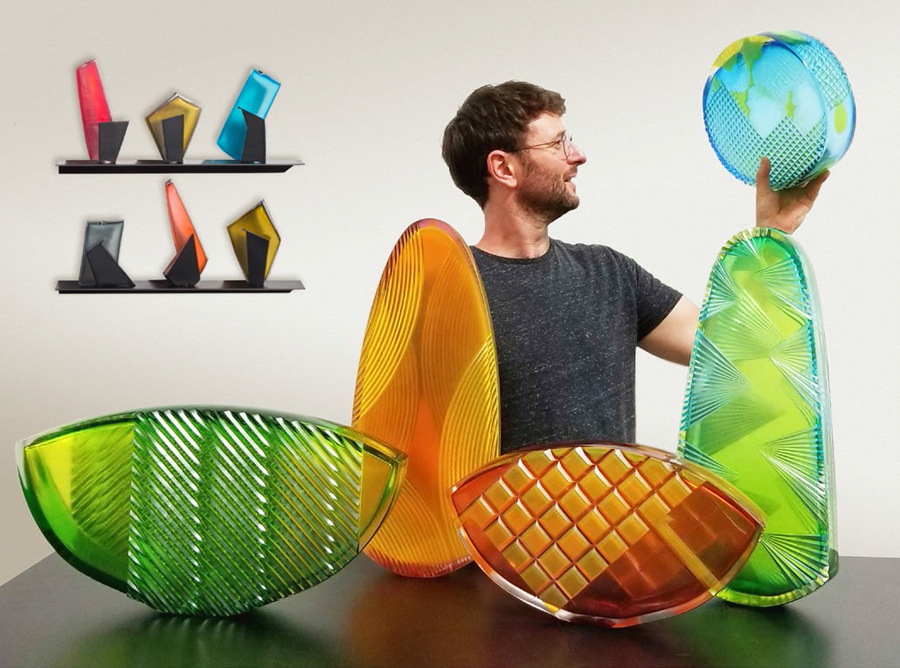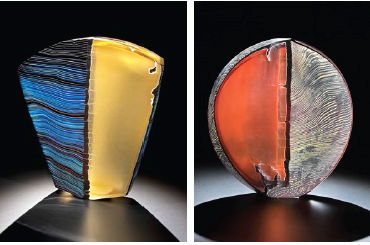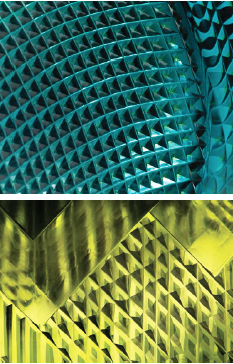Cold Cold Art - Page 2
 |
|
|
 |
 |
|
|
 |
|
|
"Because glass is molten, you can't touch it, so you don't see the hand of the maker in it so much," Ethan says.
"I'm taking the sensibility that comes from working with clay to use the cold work to put my fingerprint on the material, to show evidence of the cutting, of the carving."
He also brings a bit of the painter to his work.
"I can create painterly images on one side, and then another image on the other side, so you can play one against the other," he says.
In addition to both celebrating and subverting glass as a material for art, Ethan both celebrates and subverts the history of glass, by using early 20th century tools of cutting crystal to create 21st century glass.
An inspiration for his etched glass was an old-fashioned set of crystal inherited from his grandmother. "Nobody else in the family wanted the collection, so her crystal has been in my studio since," he has said.
"I have always tried to have a good grasp on the history of glassmaking, from the ancient times through the glass factories to Studio Glass," Ethan says. "I want to take that history, and still have an original voice."
What Ethan adds to the stylistic mix is the way he takes an old-fashioned method for creating old-fashioned glass—cut crystal and engraving—and uses it to create something of our time.
"With American cut glass, the patterns are so busy. You see plants, flowers, and birds," he says, adding, "I've chosen to take that history and technology and push them forward, and use them in a more modern, minimal way."
"I like the minimal quality of modernist architecture and design," he says. "Everything is very sensible and clear." Ethan has worked in Japan, where he has also taken inspiration from the minimal forms of Japanese ceramics.
Ethan's 'Crosscut' series makes use of cut crystal techniques, creating intricate cut designs that can suggest Op Art.
He also creates other series of work, including the 'Coastline' series, in which several layers of colored glass are overlaid over a translucent glass. While they suggest coastlines, Ethan says the work is abstract.
Using the whirling wheel and grinders, Ethan etches away portions of the upper layers to produce what can appear to be archipelagoes.
"When I started 'Coastline,' then I felt it was something unique to my voice. It's when I started using carving in a new way," says Ethan, who grew up in Ithaca, New York, not far from the Corning Museum, where he had his encounter with antique cut glass.
It's was while doing the 'Coastline' series that his career began to blossom. Ethan, who had studied art in upstate New York and Australia, was creating and teaching art in the Seattle area, one of the centers for Studio Glass.
"I was doing well, showing at galleries, sales were pretty strong. That was when my career started building," he says. In 2010 he won the 'Best Emerging Artist' award from the Tacoma Museum of Glass.
Dani Montague, who shows Ethan's work in her Montague Gallery in San Francisco, which specializes in glass, loves that his work seems both complex yet simple, combines opacity with translucence, and creates shadows and plays of light.
She says it's hard to find artists who do work like his. "You can recognize his work. He's developed a signature style," Montague says. "He's been pushing the envelope, and he's evolving, and I like that too. I like to see new directions in an artist's work."
Tom Kasten, who with his wife has put together a large collection of Studio glass at his Peninsula home, admires in Ethan's work "the simplicity of it and the integration with nature his pieces have."




